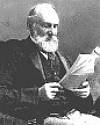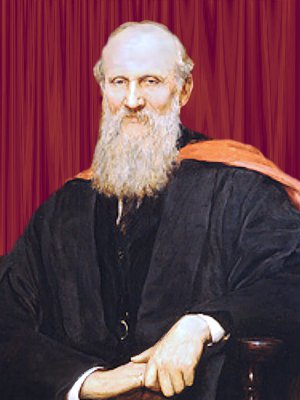 (source)
(source)
|
Baron William Thomson Kelvin
(26 Jun 1824 - 17 Dec 1907)
Irish physicist, mathematician and engineer , born as William Thomson in Ireland, he became an influential physicist, mathematician and engineer who has been described as the Newton of his era.
|
Lord Kelvin
from Famous Men of Science
by Sarah K. Bolton

Lord Kelvin (William Thomson in private life) is rated as one of the world's great physicists. He taught, and himself acted on the belief, that “the best performance of the everyday occupations of mankind are those to which the principles of science are rigidly applied.” The term “applied science” has been given to the kind of work which he thus instituted.
Lord Kelvin's achievements were many and diverse. He formulated the dissipation of energy principle that is summarised in the second law of thermodynamics. His knowledge of engineering made it possible to lay the first telegraph cable across the Atlantic Ocean. He invented a temperature scale, instruments for receiving cable signals, a mariner's compass, and a deep-sea sounding apparatus. He made significant contributions to the theories of elasticity, magnetism, vortex motion, and electricity. His lectures fill three volumes; his articles seven.
William Thomson was born in Belfast, Ireland, on June 26, 1824. He was the second son of Professor James Thomson, head of the mathematical department of the Royal Academical Institution - whose family originally had emigrated from Scotland to escape religious persecution. William's mother, who was the daughter of a Glasgow merchant, died while her children were still young and Professor Thomson alone reared his five sons and three daughters.
In 1832, when William was eight years old, his father went to teach in the mathematical department of Glasgow University, the same university where one day William would also teach. Even before William's time, Thomsons were not unusual among the Glasgow faculty. In fact there were so many of them that students and townsmen often spoke of the school as the Thomsonian University. Both William and his elder brother, James, showed remarkable mental abilities when they were boys. At the ages of ten and twelve respectively they were able to pass entrance examinations at the university. There they held their own among their fellow students although their subjects were difficult. They studied Newton's Principia, Lagrange's mathematical work, Theory of Functions, as well as philosophy, logic, chemistry, Latin, and Greek. Competition in their class was keen; one of their fellow students was John Caird, who afterwards became head of the university.
In the summer of 1840, Professor Thomson took William and James with him on a tour through Germany. He wanted the two boys to have an opportunity to study the German language at first hand. Unfortunately for the success of this project, William discovered a book - Fourier's work on mathematical physics which completely absorbed him, and had a deep influence on his later career. He had no time for speaking German.
In 1841, on his father's advice, William entered St. Peter's. There he was assigned to a tutor, as the custom was, and began to study mathematics. Before long he was contributing articles to the Cambridge Mathematical Journal and gained a reputation for brilliance. He was also interested in rowing and swimming and showed such aptitude for music that he was made president of the university musical society.
The highest honor a student of mathematics could win in those days was top place on the Cambridge Mathematical Tripos lists - in other words, highest score in the tripos contest. Those who competed in the contest were called “Wranglers,” and the student who came out ahead was known as “Senior Wrangler.” Every mathematics student aspired to this honor, and William, whose record was outstanding so far, had a good chance to win it. He and his father anxiously awaited the results of the examination. The post of professor of natural science was vacant at Glasgow University. Professor Thomson wanted his son to get the post, and it would probably be his if he became Senior Wrangler.
When the results of the tripos contest were announced, William was second on the list. A student named Parkinson, from another college, had won the top honor. However, there was another mathematical award, Smith's Prize, for which William still had a chance. He entered the competition, as did Parkinson; this time William placed first and Parkinson second. After the competition, one of the examiners said to another, “You and I are just about fit to mend young Thomson's pen.”
Soon after William won Smith's Prize and acquired a tide for himself after all - “Smith's Prizeman” - he was offered the professorship he wanted at Glasgow. But before he settled in Scotland, he went to Paris to study under the great physicist Regnault, who was working in thermodynamics. William also visited London, where he met Michael Faraday.
When he began to teach at Glasgow University, where he remained for fifty-three years, William Thomson was twenty-two years old. His first, or inaugural, lecture was an outline of the scope and methods of physics. It was considered an excellent piece of work but was badly presented because Thomson was so nervous.
As time passed, he lost his self-consciousness and went to the other extreme, often forgetting during a class that he was talking to students and not to himself. Something in the subject matter would suggest an idea to him and he would cover the blackboards with figures that meant nothing to his audience. Many of his pupils were present only because their course required a certain number of credits in physics. They made no effort to follow their professor on these intellectual excursions and consequently were bored. “I listened to his lectures on the pendulum for a month,” one of his students said, “and all I know about the thing yet is that it wags.”
Professor Thomson was popular, however, with students who loved physics. They were interested in his digressions and appreciated the way he used clear physical meanings instead of stereotyped textbook phrases. They went to him for help with their own scientific projects - both when they were students and later in life - and he gave them complete attention, encouragement, and enlightened criticism.
Sometimes in class Thomson illuminated a point with lightning clearness. For example, he once asked a student to explain the meaning of the symbol dx/dt. “Sir,” answered the young man, “it denotes the limiting value of the ratio of the increment of x to the increment of t when the latter increment is indefinitely diminished.” “Hmm,” observed Thomson shortly, “that's what Todhunter would say. Does nobody know that it represents a velocity?”
Fortunately for Professor Thomson's own research, the university sessions lasted only six months of the year, and he was left with considerable free time for his own work. Some of this had to do with electricity. He discovered how to determine the unit of current in both the volt and the ampere and established the measuring unit known as the standard ohm by applying to his measurements of the volt and ampere the consequences of Ohm's Law.
He played a part, too, in one of the most dramatic discoveries of the twentieth century - wireless telegraphy. That it was possible to produce an oscillatory current in a Leyden jar had first been postulated by Joseph Henry. This idea had been regarded as a rather wild speculation until Thomson, in a brilliant paper delivered before the Glasgow Philosophical Society, confirmed Henry's idea. (Later it was proved experimentally by still another physicist.) In the same paper, Thomson presented a formula for determining the rapidity of the oscillations. Building on these ideas, James Clerk Maxwell, a contemporary of Thomson, showed that if the oscillations could be made sufficiently rapid, much of the energy stored in a Leyden jar could be radiated into space in the form of electromagnetic waves. Heinrich Hertz developed the idea still further. Not only did he produce such waves, he devised a method for receiving them - and then it only remained for such men as Marconi and Sir Oliver Lodge to work out the practical applications and make wireless telegraphy a reality.
Before he settled down at Glasgow University, Thomson had gone to Paris to study thermodynamics, or the theoretical relationship between work and heat. His teacher, Regnault, had done some important experiments on steam, and the French physicist, Nicolas Carnot, had discovered that it was possible to convert mechanical work into heat and that the reverse was also true: heat could be converted into work. Moreover, he had found that to a given amount of mechanical work there is a corresponding definite amount of heat. Little attention had been paid to these discoveries, but Thomson thought they were important. He wrote an article about them that was widely discussed by other scientists and gave these discoveries the attention they deserved.
Thomson himself did research in the field of thermodynamics, research that led to the development of the conservation of energy law, which holds that the sum total of all energy in the universe remains constant.
Thomson's law became more important when the actual mechanical equivalent of heat was determined. This was done by James Prescott Joule, an amateur scientist who was a Manchester brewer by trade. After many experiments, he had obtained a result of 778 foot-pounds of work as the mechanical equivalent of the pound-ºF. The Manchester Guardian publicised his discovery, but the other English newspapers were not impressed. This did not matter to Joule, who realised that his work was potentially important. He succeeded in getting permission to read a paper about his discovery before the British Association at Oxford. Before the meeting, the chairman, thinking Joule's paper to be of little value, had advised him to be brief. Therefore Joule skimmed through his paper, and the little he did say was barely heard, because he was so nervous. (Thomson said later that “there was no consciousness in the very unassuming young man's manner that he had a great idea to unfold.”) The chairman was about to pass on to another subject without asking for questions or further discussion, when Professor Thomson jumped to his feet. He asked the audience to consider how Joule's discovery might be used to determine the amount of energy changed to heat when an electric current flows through a wire. Today Joule's Laws are standards in thermodynamics.
Thomson was indebted to the research of Carnot and Joule for the clues that led him to develop his absolute temperature scale, which is independent of the properties of any thermometric substance and is used principally in thermodynamics. The Kelvin scale starts with the lowest possible temperature and calls it absolute zero. Since Thomson utilised centigrade divisions, the freezing point of water, or 0º centigrade, became 273º in his scale, and the boiling point of water, or 100º centigrade, became 373º Kelvin.
William Thomson was interested in all the scientific problems of his time, and inevitably he became involved in the development of telegraphic communication between England and America. In 1850 an experimental line had been laid across the English Channel between Dover and Calais. This cable was made of copper wire, insulated with the rubberlike substance, gutta-percha. In the try-out the signals received were characterised as “extraordinarily sluggish” and after a few hours, all communication ceased. The line had been severed by the anchor of a fishing smack. It would not be hard to make a stronger cable, but something had to be done to clarify the signals.
William Thomson knew that the cable was in effect an elongated Leyden jar of great capacity. The copper acted as the inner lining, the salt water as the outer lining, and the gutta-percha as the glass of the jar. When a battery is connected to one end of the core, the “Leyden jar” gradually gets charged up, first at the battery end, gradually farther and farther along the wire, and so to the other end. When the battery is withdrawn (or the circuit broken), the discharge is equally gradual.
Extending this principle, Thomson worked out a theory of the telegraph. The retardation of the electric impulse along a cable, he said, was proportional to the capacity and the resistance of the cable, and each of these quantities was proportional to the length to such an extent that the time retardation of a signal was in actual practice proportional to the square of the length.
He illustrated: “If a cable 200 miles long showed a retardation of one-tenth of a second, one of similar thickness that was 2000 miles long would have a retardation 100 times as great, or ten seconds.”
It seemed impossible to apply these proportions to a cable long enough to cross the Atlantic, but Thomson had a solution. He said in effect: Employ a copper cable of the lowest resistance possible, and consequently of the highest conductivity, and use the thickest cross-section obtainable. There were many objections to his suggestion, but Thomson's reputation as a practical physicist was so great that plans were laid for the forming of the Atlantic Telegraph Company. Thomson himself was named chief director.
The cable was laid successfully but signals were so weak that ordinary receiving methods were useless. Thomson's solution was the invention of the mirror galvanometer, which is today considered an essential part of the equipment of every scientific laboratory. This instrument was quite simple. To the magnet at the centre of the coil of an ordinary galvanometer Thomson attached a spherical mirror so that it hung vertically and swung with the magnet whenever a current passed around the coil. A spot of light from a lamp was reflected from this mirror to a distant scale. The scale was placed far enough away so that a tiny movement of the mirror caused a very noticeable swing of the spot along the scale. This instrument proved sensitive to even the smallest current changes and recorded very feeble currents.
More than seven hundred messages had been received and the problems presented by a transatlantic cable were apparently solved, when, suddenly, messages stopped coming. The cable had broken and it was impossible to mend it.
“We must build a new and better cable,” said Thomson. He busied himself with the plans, arranging to have a cable ship, the Great Eastern, carry the whole length of cable required. He equipped the ship for the free maneuvering necessary to lay the cable. Two attempts were made before a successful line was laid in 1866. As electrical engineer of the expedition and the man most responsible for its success, William Thomson was knighted by Queen Victoria.
As time passed, Thomson found that his mirror galvanometer did not operate quite as efficiently as he wished. Eventually he replaced it with a siphon recorder. Part of this instrument was a small pen, made of glass tube and shaped like a siphon. One end of the pen dipped in an ink bottle, the other end wrote messages in little zigzag notches on a ribbon of paper drawn past it by machinery. The siphon-pen was moved by signal currents which flowed in a small coil hung between the poles of an electromagnet. The ink spurted from the pen to the paper in a succession of fine drops. This was done by electrifying the ink bottle and ink and keeping the paper in contact with an uninsulated metal roller. Attraction between the electrified ink and the unelectrified paper thus drew out the ink drops. Since the pen never touched paper, it was not retarded by friction.
While Thomson was working on transocean cables, he watched sailors repeat the inaccurate and time consuming process of deep-sea sounding which was so important in laying cable. The ship would be stopped, a rope with a sinker at the end lowered into the ocean; then after it had reached bottom, it would be hauled up again and the paid-out line measured.
Thomson thought of a better way to measure the depth of the sea. He would use piano wire, which could be wound mechanically, and his sounder would be a glass tube, of small diameter, with the upper end stopped. The tube's interior would be coated with silver chromate, a chemical that changes colour upon contact with salt water. When this tube was weighted and dropped into the sea, open end first, water pressure would increase as the tube sank to lower and lower depths. As the air trapped in the tube was increasingly compressed, more and more silver chromate would be exposed to the action of salt water. When Thomson's sounder was removed from the water, the ocean depth could be calculated from the height of discoloration on the tube.
Thomson had to experiment for a while before he perfected this invention. One day Joule found him surrounded with piano wire. When Joule asked what he was doing, Thomson replied, “Sounding.”
“What note?” Joule asked, and Thomson promptly replied, “The deep C.”
Today Thomson's sounding device, which has evolved into a seven-strand steel cable three hundred fathoms in length, is still in use, and has saved countless ships from running aground. “Heave Thomson over!” commands the navigation officer whenever he wants to know the depth of the sea.
When Thomson was asked to write an article on the mariner's compass for a technical journal, he found that he knew very little about it. He studied the compasses then in use, and was surprised at how faulty they were. The needles were heavy, often fifteen inches long. They were mounted on large cards, supposedly to make them steady, but in fine weather they often stalled, and in stormy weather they were practically useless. After reading some studies of compass deviation, Thomson decided that a shorter needle mounted on a lighter card would be an improvement. “A slow horizontal swing will avoid unsteadiness,” he said, “besides lessening the amount of friction to prevent sticking.” He also realised that it was essential to shield a compass from the magnetism of the ship's ironwork. His improved mariner's compass was used almost universally until the advent of the gyrocompass.
Next Thomson turned his attention to lighthouses and suggested a system whereby one light could be distinguished from another. He made a study of the tides and a tide-predicting instrument. As a result of his mathematical investigation of waves, he made improvements in ship design. Thomson's fame reached such proportions that a sailor once said, “I don't know who this Thomson may be, but every sailor ought to pray for him every night.”
In 1892, Queen Victoria raised Sir William to the peerage. He chose the title of Baron Kelvin of Largs, to perpetuate the name of the Kelvin River near Glasgow University. Honours from governments, scientific societies, and universities came to him from all over the world. He was president of the London Royal Society for five years, and of the Edinburgh Royal Society four times. In 1896 all Glasgow honoured him for having completed a half-century as Professor of Natural Philosophy at the university. Representatives of many governments and scientific societies gathered to pay him homage.
Lord Kelvin remained at his university post for three years longer. Then, when he was seventy-five, he retired from his professorship. He was succeeded by Andrew Gray, a former student and assistant who later wrote a biography entitled Lord Kelvin.
Lord Kelvin by no means gave up his work when he retired from his professorship. On the very day of his resignation he enrolled as a special student in scientific research. For eight years longer he worked, hale and hearty “except for occasional bouts of facial neuralgia.” He died on December 23, 1907, and was buried beside Sir Isaac Newton in Westminster Abbey. “There,” says Andrew Gray, “he sleeps well who toiled during a long life for the cause of natural knowledge, and served nobly, as a hero of peace, his country and the world.”
In May 1921, scientists gathered at the Institute of Civil Engineers to award the newly created Kelvin Medal. In his speech on that occasion, Lord Balfour said:
Lord Kelvin had, in a manner hardly and perhaps never equalled before, except by Archimedes, the power of theorizing on the darkest, most obscure, and most intimate secrets of Nature, and at the same time, and almost in the same breath, carrying out effectively and practically some engineering feat, or carrying to a successful issue some engineering invention. He was one of the leaders in the movement which has compelled all modern engineers worthy of the name to be themselves men not merely of practice, but of theory, to carry out engineering undertakings in the spirit of true scientific inquiry and with an eye fixed on the rapidly growing knowledge of the mechanics of Nature, which can only be acquired by the patient work of physicists and mathematicians in their laboratories and studies.
- Science Quotes by Baron William Thomson Kelvin.
- 26 Jun - short biography, births, deaths and events on date of Kelvin's birth.
- Lord Kelvin Biography - one of the earliest pages written for this site.
- William Thomson Kelvin - context of quote “Make a mechanical model” - Medium image (500 x 250 px)
- William Thomson Kelvin - context of quote “Make a mechanical model” - Large image (800 x 400 px)
- William Thomson Kelvin - context of quote “Many of the greatest advances” - Medium image (500 x 250 px)
- William Thomson Kelvin - context of quote “Many of the greatest advances” - Large image (800 x 400 px)
- William Thomson Kelvin - context of quote “The rewards of accurate measurement” - Medium image (500 x 250 px)
- William Thomson Kelvin - context of quote “The rewards of accurate measurement” - Large image (800 x 400 px)
- William Thomson Kelvin - context of quote “I have no satisfaction in formulas” - Medium image (500 x 250 px)
- William Thomson Kelvin - context of quote “I have no satisfaction in formulas” - Large image (800 x 400 px)
- William Thomson Kelvin - context of quote “Mathematics is … etherealisation of common sense” - Medium image (500 x 250 px)
- William Thomson Kelvin - context of quote “Mathematics is … etherealisation of common sense” - Large image (800 x 400 px)
- William Thomson Kelvin - context of quote “Measure … and express in numbers” - Medium image (500 x 250 px)
- William Thomson Kelvin - context of quote “Measure … and express in numbers” - Large image (800 x 400 px)
- William Thomson Kelvin - context of quote “Imaginary difficulty of making a change” - Medium image (500 x 250 px)
- William Thomson Kelvin - context of quote “Imaginary difficulty of making a change” - Large image (800 x 400 px)
- William Thomson Kelvin - context of quote “Questions of personal priority” - Medium image (500 x 250 px)
- William Thomson Kelvin - context of quote “Questions of personal priority” - Large image (800 x 400 px)
- William Thomson Kelvin - context of quote “Science is not antagonistic to religion” - Medium image (500 x 250 px)
- William Thomson Kelvin - context of quote “Science is not antagonistic to religion” - Large image (800 x 400 px)
- William Thomson Kelvin - context of quote “Simplification of modes of proof” - Medium image (500 x 250 px)
- William Thomson Kelvin - context of quote “Simplification of modes of proof” - Large image (800 x 400 px)
- William Thomson Kelvin - context of quote “Mathematics is the only true metaphysics” - Medium image (500 x 250 px)
- William Thomson Kelvin - context of quote “Mathematics is the only true metaphysics” - Large image (800 x 400 px)
- Excellent Kelvin Biography history at the BBC education site for the Local Heroes TV series.
- Construction details for "Kelvin's Thunderstorm" - Lord Kelvin's water-drop electrostatic generator..
- Kelvin at three different ages - a photo gallery across his life.
- Collection of pictures of Kelvin at different ages - at the MacTutor site.
- Informative Biography of Kelvin - with additional resources at the MacTutor site.
- History of Submarine Cables - a 150 Year History of Submarine Cables.
- Timeline of Atlantic Cables - 1856 to 2015.
- Lord Kelvin's Conjecture Disproved - A modern improvement on Kelvin's 1887 geometrical conjecture.
- Degrees Kelvin: A Tale of Genius, Invention, and Tragedy, by David Lindley. - book suggestion.
- Booklist for William Thomson.







